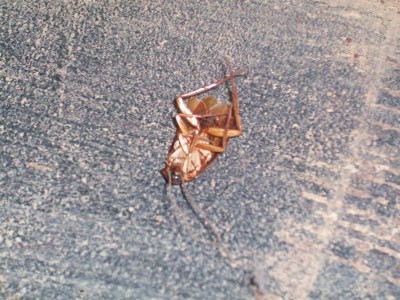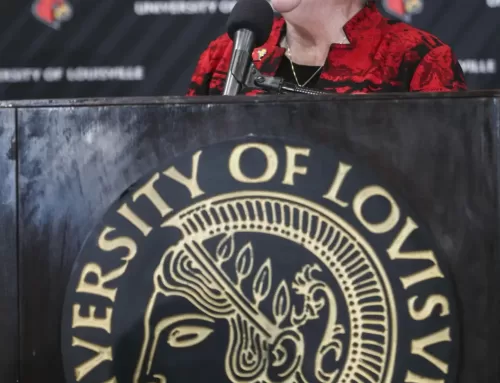By Cassie Glancy & Christine Flannery–
With the mold outbreak in Miller, many U of L students, faculty and staff are left to wonder whether the rooms they are sitting in are clean. The belief is spreading quickly that the majority of the university’s buildings, especially the Arts and Sciences buildings, are old, outdated and unclean. Students, faculty and staff are confused about who is responsible for the conditions of these buildings, why disparities exist between schools on campus, what the possible health ramifications are and why more money is not being allocated toward these problems.
The Physical Plant director of custodians, Ivrin Williams, said that each building is cleaned the same. He said that his workers come in every morning at 4 a.m. and clean every classroom, common areas and bathrooms on the Belknap, Shelby and Health Sciences campuses.
The physical plant “tries to focus on quality service to all entities,” said Williams. He said that no building receives special treatment over others. However, many U of L students and staff members disagree. They say that buildings such as Davidson and Strickler are much dirtier than the School of Music, Grawemeyer Hall and the College of Business.
Sumer Smith, a student at U of L said, “I can tell that some of my classes are much cleaner than others. When I walk from the School of Music to my biology class in Strickler, it is like a whole different world. I feel as if Strickler and the Natural Sciences buildings are out of date and grimy. I feel gross when I am in the classes.”
Jeremy Mobley, a political science major, also noticed dissimilarity between the buildings. “Compared to the buildings of other schools, especially the Business school, the A&S buildings fall short. This semester, I have a class in the Business School and then go straight to Ford Hall for another class. I feel like I’m going from one of the cleanest and most technologically well equipped buildings, to one of the oldest and worst equipped buildings on campus,” said Mobley.
Arts and Sciences buildings like Strickler, Davidson and Humanities experience heavy traffic flow. Each student is required to take 34 credit hours of General Education Requirements. The majority of these classes are held in Arts and Sciences buildings. Since each student in the university must take a class in at least one of these buildings more money and time should be spent on cleaning these facilities.
Although some buildings on campus can be regarded as unsanitary, the Physical Plant employees are trained every six months. Williams said that U of L custodians go through vigorous training in a classroom setting that involves films and the custodians are given a training manual.
Williams also said that the majority of his workers come from a government entity called Mainstream. He described the organization as a way for teenagers to get involved with custodial work.
The Health Sciences campus is treated with more caution because of the hazardous materials. The custodians there are trained to act as if everything is a hazardous material. No extra caution is taken for other buildings on campus. The only extra considerations come with the flu and cold season. Williams said that the custodians will wipe off the doorknobs and light switches with germicidal cleaner.
Many students are taking up the responsibility of cleaning their own classrooms. Students in the Schnieder Art School say that they have to clean their own environment. Professor Che Rhodes has his students sweep the floors and clean up after themselves. The students believe that if they do not do this, the classroom will be a disaster.
The drawing class is noticeably dirty as well. The air vents and floors are covered in black charcoal. Students from last year’s drawing class said that they did not recall the floor being cleaned until after the semester was over.
When walking through Strickler Hall, the corners in the bathroom floors are covered in dust mites and mold is on the wall near the toilets. On Saturday, Nov. 3, popcorn pieces were found in the stairwell. Though it cannot be proven, the popcorn more than likely came from a REACH event held four days earlier on Tuesday, Oct. 30 in Strickler’s lobby.
Williams said that the floors get mopped and vacuumed daily, and once a month all of the areas get steam cleaned with a germicidal solution. He said that U of L’s Physical Plant attained the steam cleaner last year as a move toward sustainability. The new investment has saved U of L $20,000.
The ecofriendly equipment does not appear to be doing its job. The health risks that are associated with working in and being exposed to an unsafe environment can cause long-lasting problems. Staphylococcus, also known as Staph infection, lingers on surfaces when not properly cleaned. Other illnesses caused by unsanitary conditions include allergies and asthma.
The students are not the only ones who are suffering from the unclean environments. Many professors have commented on the issue as well, saying that their offices remain unclean unless they do the cleaning themselves.
Williams, on the other hand, said that every office is cleaned once a week. The procedure he described involves a note card being placed on each door, which states when the custodians will clean their offices.
He said that the garbage is taken out, carpets are cleaned and the desks are wiped off. He added that the custodians do not like touching the professor’s personal items and ask the professors to remove the items before their offices are cleaned.
Katherine Taylor, director of Basic Communication courses in the Department of Communication, said that she has someone clean her office carpets and take out her trash every so often. She said that she is notified before this will happen, but that there is not a regular and set cleaning schedule. She said that the surfaces of her desks are never wiped clean.
The buildup of dirt can cause problems with those who suffer from allergies. Allergies left untreated lead to sinus infections, asthma and even lung disease. Not only dirt can contribute to serious allergy problems; cockroaches can be found in the basement, stairwells and offices of Strickler Hall. The Asthma and Allergy Foundation of America website says that if you see one roach you can safely assume that there are 800 living in the building. People living in inner-cities and southern states are more likely to have a problem with the cockroach allergen, and 23 to 60 percent of urban residents with asthma are sensitive to the cockroach allergen. Cockroach allergens can cause moderate to severe allergic reactions.
The European Lung Foundation’s website says, “The work environment can cause lung diseases because of allergy, irritation or a build-up of tiny particles in the lungs… other diseases can be caused by dust, silicosis, asbestos, asbestosis, and coal dust: coal miner’s pneumoconiosis.”
Gottschalk Hall is currently being treated for asbestos. Although asbestos is not caused by an unclean environment, some variations of asbestos are visible to the naked eye and should have been immediately reported by Physical Plant personnel.
In a 16-week semester, a student spends an average of $34.50 each hour spent in class. All of the students interviewed said that they feel this money could be better spent by the university to benefit their education.
Devyn Yager, a marketing major, said that she feels that this money is not going towards things to help the quality of education, but instead toward things that make U of L appear better to outsiders. This complaint was echoed by Shawna Burnett, a communications major. These students said that they would rather see their tuition be spent inside of the classroom instead of on new landscaping and fountains such as those on Cardinal Boulevard.
Burnett finds the drawings on desks, dingy and dirty walls, rips in the carpet and the general “moldy” smell of rooms in Strickler to be distracting and discouraging. Jon Robbins, a justice administration major, said that he feels as though he is not a valued student due to the physical condition of Brigman Hall where most of his classes are held.
Lucas Smith, a marketing major and communication minor, said, “I feel that a positive environment, which includes ambient conditions, is crucial to a good education. The seemingly lack of overall maintenance on these, Arts and Sciences buildings does make the process of enjoying the education more difficult.”
It is the Physical Plant’s responsibility to maintain a safe and attractive campus environment. Students and teachers feel that the Physical Plant’s diligence to clean all campus buildings the same is sub-par. Their inability to provide U of L students with the quality they deserve brings up the age old question. What came first? The cockroach or the crumb?
[email protected]
Photos by Christine Flannery/The Louisville Cardinal





